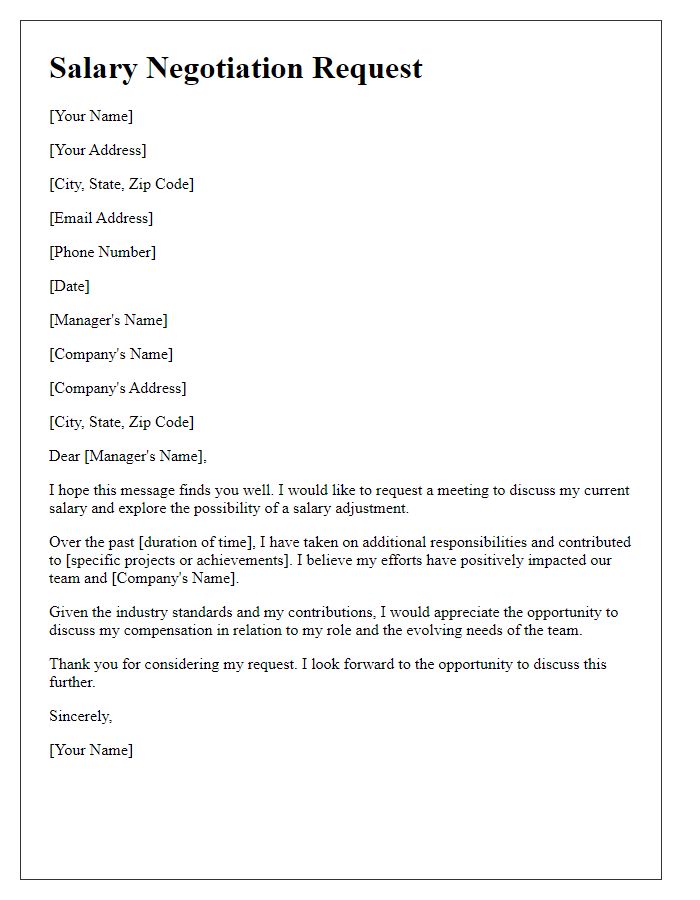Navigating the world of salary negotiation can feel daunting, but it doesn't have to be! In this guide, we'll walk you through a well-structured letter template that empowers you to advocate for your worth confidently. With the right approach and key elements in place, you'll be able to present your case in a professional manner that resonates with your employer. Ready to boost your earning potential? Let's dive into the details!

Highlight achievements and contributions
During the past year, I have successfully led multiple projects, such as the digital marketing campaign for the product launch in June 2023, which resulted in a 25% increase in sales compared to last year. My proactive approach to streamlining internal communication by implementing the new project management software in September 2023 has improved team efficiency, resulting in a 15% reduction in project turnaround time. Additionally, I organized training sessions that enhanced team skill sets and led to a 10% increase in overall productivity. My commitment to our organizational goals and consistent performance has not only contributed to team successes but has also helped in building stronger client relationships, evident from the positive feedback received from our clients in the annual survey conducted in December 2023.
Research and provide market salary data
Effective salary negotiation requires comprehensive market salary data pertinent to industry standards, job roles, and geographic location. For instance, software engineers in major tech hubs like San Francisco often command salaries around $130,000 annually due to the high demand and cost of living. According to the Bureau of Labor Statistics (BLS), the median annual wage for software developers in the United States is approximately $112,620. Furthermore, resources like Glassdoor and Payscale provide insights into company-specific compensation trends. Researching these figures enables employees to articulate their value based on tangible market evidence, ensuring informed discussions with management regarding fair remuneration adjustments.
Specify desired salary range or percentage increase
Employees often seek salary negotiations to align their compensation with industry standards or personal financial needs. A typical desired salary range may fall between 10% to 20% increase based on current market trends. For instance, if the current salary is $50,000, a 15% increase would suggest a target of $57,500, reflecting relevant benchmarks from sources like the Bureau of Labor Statistics or industry salary surveys for similar positions. Understanding the company's financial health, recent budget adjustments, and performance metrics can also play a crucial role in strengthening one's negotiation stance.
Express appreciation and loyalty to the company
Employee salary negotiation often begins with acknowledging the company's positive environment and expressing gratitude for opportunities received. Loyalty to the organization demonstrates commitment and willingness to contribute further. Recognizing accomplishments, skills developed, and success achieved within the workplace reinforces value. Emphasizing dedication to the company's goals and future vision can strengthen the case for salary adjustment. The negotiation focuses not only on current market trends but also on the employee's unique contributions to team projects and overall performance, highlighting readiness to take on increased responsibilities.
Propose a meeting for further discussion
An employee seeks a salary negotiation meeting to discuss compensation adjustments related to performance and market standards. This meeting aims to address contributions made to the company, such as exceeding sales targets or leading successful projects. During the discussion, the employee plans to present research on industry salary benchmarks, highlighting the need for competitive pay to retain talent and ensure morale. By pointing out specific achievements and contributions, the employee hopes to create a compelling case for a salary review that reflects their value within the organization. This strategic approach aims to foster a collaborative conversation, focusing on mutual benefits for both the employee and the company.
Letter Template For Employee Salary Negotiation Samples
Letter template of salary increase proposal for performance-based review

Letter template of compensation adjustment request after additional responsibilities

Letter template of pay raise discussion for industry standard comparison

Letter template of wage renegotiation following certification or training completion










Comments